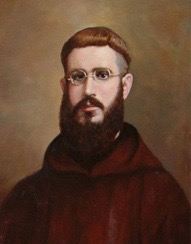Capuchin martyr (1909-1936)
 Santiago Mestre Iborra was born 10 April 1909 and baptised 12 April in the parish of san Antonio Abad in Rafelbuñol. He was the seventh of nine children born to Onofre Mestre and Mercedes Iborra. All died together as victims of the same religious persecution.
Santiago Mestre Iborra was born 10 April 1909 and baptised 12 April in the parish of san Antonio Abad in Rafelbuñol. He was the seventh of nine children born to Onofre Mestre and Mercedes Iborra. All died together as victims of the same religious persecution.
Even as child Santiago stood out for his piety. Acquaintances say that he was a model boy and exemplary in everything. He entered the Capuchin Order at twelve years of age. He took the habit on 6 June 1924 at Ollería (Valencia). He made temporary vows on 7 June 1925 and perpetual vows in Rome on 21 April 1930 before Br. Melchior de Benisa, Minister General of the Order. He was ordained priest in Rome on 26 March 1932.
After his doctorate in theology at the Gregorian University he returned to Spain and was appointed vice-rector of the Seraphic Seminary at Massamagrell. In his short religious life he distinguished himself for his devotion to the Virgin Mary, his simplicity, obedience and humility and as a man of a deep interior life. His confreres in the Order said of him, “He had a good character and lively temperament … The faithful regarded him as an exemplary religious … Even with his gifts of his learning and virtue, he always showed himself to be humble and simple… He was always dedicated to the apostolates proper to his condition as a religious.”
At the outbreak of the National Movement, Br. Santiago sought to protect the seminarians entrusted to his care. Then he sought refuge in his home town of Rafelbuñol. Then the local Committee put him to work as a labourer in the works being done in the Abbey at the time, receiving scraps from the parish church, and was able to lead a normal life. One day he received news that his brothers had been detained by the Committee and that their lives were at risk. He said to himself, “I will go to the Committee to see if they will take me prisoner in exchange for the freedom of my brothers.” When he presented himself to the Committee, he was taken with his brothers and imprisoned on 26 September 1936. In prison he heard the confession of all the prisoners. On the night between the 28 and 29 September the prisoners were led to the cemetery at Massamagrell. As they passed in from of the Church of Our Lady they acclaimed her. When they reached the cemetery, to the cry of “Long live Christ the King” they were shot.
Killed with his brothers, Br. Santiago was buried in a common grave in the cemetery of Massamagrell. His remains were exhumed and identified and then transferred to the shrine of the Fallen of Rafelbuñol. Today his remains rest in the Chapel of the Capuchin Martyrs in friary of St. Mary Magdalene at Massamagrell.
Translation based on http://www.santiebeati.it/dettaglio/93156 (06 July 2090)
